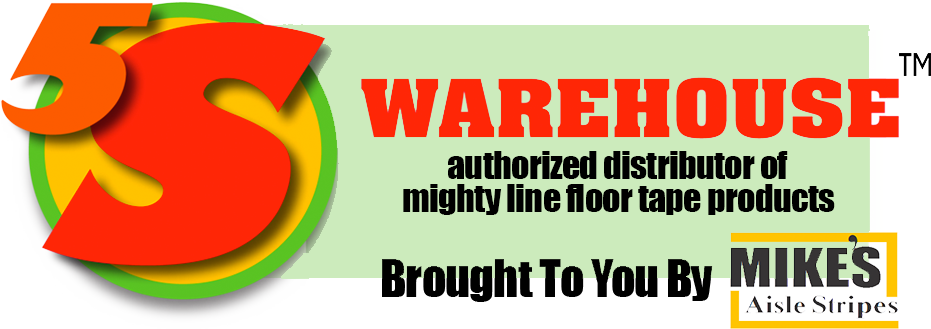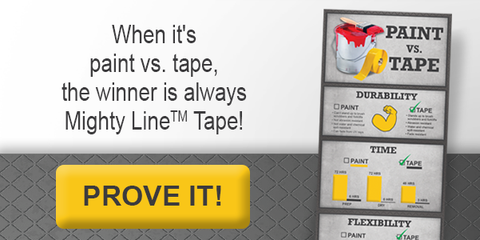Can You Afford to Paint Floor Lines?
 During your plant's annual maintenance shutdown, contractors painted floor stripes to meet Occupational Safety & Health Administration (OSHA) requirements. But now, only three months later, the corners are already almost invisible while the remaining lines look faded and dingy.
During your plant's annual maintenance shutdown, contractors painted floor stripes to meet Occupational Safety & Health Administration (OSHA) requirements. But now, only three months later, the corners are already almost invisible while the remaining lines look faded and dingy.
When it's this difficult to meet basic OSHA requirements, it seems like a pipe dream to use colors to indicate hazardous areas, storage, and work-in-progress to implement 5S methodology.
Paint seemed like the cheaper option. The contractor you used during shutdown only charged you about $12,000 to stripe 30,000 linear feet of yellow floor lines while 2-inch floor marking tape would cost about $41,000. But now, you're not only facing repairs to the lines, but you also didn't notice a safety hazard, so you've got to remove and repaint some lines. And the added cost of using more colors for 5S may just break the bank.
Too many factories and warehouses fail to consider the cost in time and lost efficiency when making the decision about whether to use floor marking tape or paint. Although the initial cost of using paint may be less, over time, the investment doesn't hold up.
Tape is quicker and easier to apply
Paint frequently requires the shutdown of the plant floor. Time required to prepare the floor and apply paint may result in up to 8 days of lost work in even the smallest plant. According to Rust-Oleum, surface preparation may include a concrete patching compound to repair small surface holes, cracks and pores. This alone requires a 72-hour dry time. Also recommended is a cleaning and etching solution for the concrete and a grinder to remove old paint. The paint also requires a 48- to 72-hour dry time. Rust-Oleum also recommends an industrial or commercial sealant that requires up to an additional 72 hours to dry.
For even the smallest plant, preparation may take up to 3 full days, painting another 2 to 3, and sealing another 3. Large areas of the shop floor must be sectioned off to paint.
Can your plant afford the time it takes to paint?
Most paint contractors can stripe 5,000 to 8,000 feet per day. Using the most favorable estimate, it would take 4 days just to stripe 30,000 linear feet, not including cleaning, prep work, and sealing. Taping off the work area, concrete repair, cleaning, prep work, and sealing may more than triple the time required.
5S Mighty Line tape is double-coated with a removable pressure-sensitive, rubber-based adhesive to apply and remove quickly with no residue. Beveled edges and a low profile ensure it stands up to industrial brush scrubbers and forklift and truck traffic. The safety floor marking tape is abrasion resistant. Even if exposed to water, chemical spills, constant UV rays or other workplace hazards, it will still adhere and remain highly visible.
Tape doesn't damage concrete floors like the continued use of paint can
Shotblasting or chemical preparation is required to strip old paint and clean floors. These invasive methods may damage concrete floors, making concrete repair an essential step in subsequent applications of paint.
Floor marking tape, on the other hand, can be applied without any preparation other than a minimal sweeping and cleaning. Because vinyl safety tape doesn't require specialized equipment, it can be applied to small sections at a time with minimal work interruption.
Mighty Line(TM) 5S tape emits no noxious fumes And, because it emits no noxious fumes or VOCs, it can be applied during the workday without worker complaints.
Tape lasts longer than paint
Paint usually only looks good for about 3 months. After that, high-traffic areas, especially corners, need touching up. In other areas, the paint may look dirty and dingy due to spills or the dirt and debris workers bring in on their shoes.
More durable paints exist, but they are more expensive and require additional time for extensive preparation and sealing.
Can you afford to repaint every couple of years?
Mighty Line(TM) floor marking tape is guaranteed for 3 years. That's 3 years of use in high-traffic areas and in areas exposed to UV rays. If it does get dirty, it's washable with a floor scrubber.
Damaged tape is quicker and easier to replace than faded or dirty paint, and the replacement tape looks better than paint
As you look at the faded and dirty paint on the plant floor, you wonder how much it would cost to patch some of the lines and corners.
Research shows that most warehouse operations, despite complaints about fumes, choose to use their own staff during the workday to patch paint marking lines. The usual procedure is to section off a small portion of the plant at a time, clean the floor, paint over the faded, smudged or dirty lines, then let the paint dry for up to 72 hours.
The problem with painting over old paint is that the new coat can frequently be bumpy and sloppy-looking. Employees are not painting experts and simply can't do as good a job as professionals.
Can you afford to have the OSHA inspector think your plant's safety procedures are as sloppy as painted safety lines?
No special preparation is required to ensure safety marking tape stays secure and colorful for years. The surface must be clean, dry and free of debris to apply. To replace Mighty Line tape, simply cut out the damaged portion and remove. The peel-and-stick adhesive leaves no residue. Then, simply run new tape. The process takes minutes instead of days.
It's easier to use different colors with tape than with paint
All your walkways are marked with yellow paint. You chose yellow because that meets OSHA requirements, and the painters would have charged you a lot more to add any other colors. They told you that it would take additional time to wait until the yellow paint dried before they could add any colors at intersecting areas. Their estimate also included time spent cleaning their equipment to change to the new paint. The addition of a second paint color anywhere near the first paint color would have taken another 5 days of shutdown.
However, you'd really like to institute 5S methodology to make your plant more efficient, organized and safer. Different paint colors are critical in 5S methodology and a lean manufacturing environment.
Mighty Line tape comes in more than 10 colors and several patterns. 5S Warehouse also offers freezer and glow-in-the-dark tape and floor signs.
Tape is not an all-or-nothing proposition
Then it comes to you: Why not start implementing 5S with Mighty Line marking tapes? You can begin by marking certain sections; then, as the paint wears out, it can be replaced by tape.
Using tape after paint is not difficult. Unlike paint, safety floor marking tape can be used effectively on imperfect floors, so even if a plant has damaged floors from years of paint application, 5S's quality floor marking tape can be used. Its application also saves thousands on floor repairs or reconstruction.


